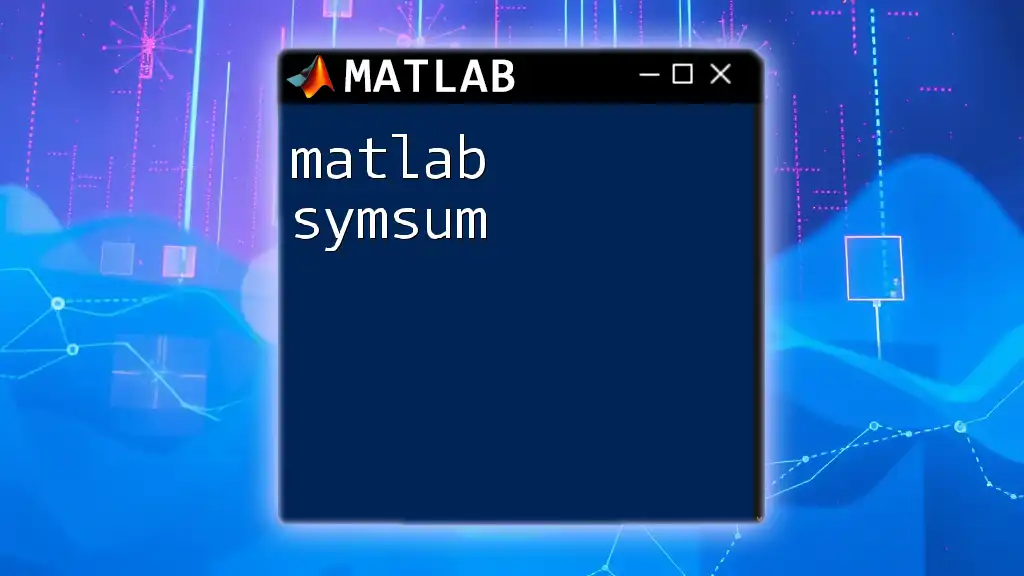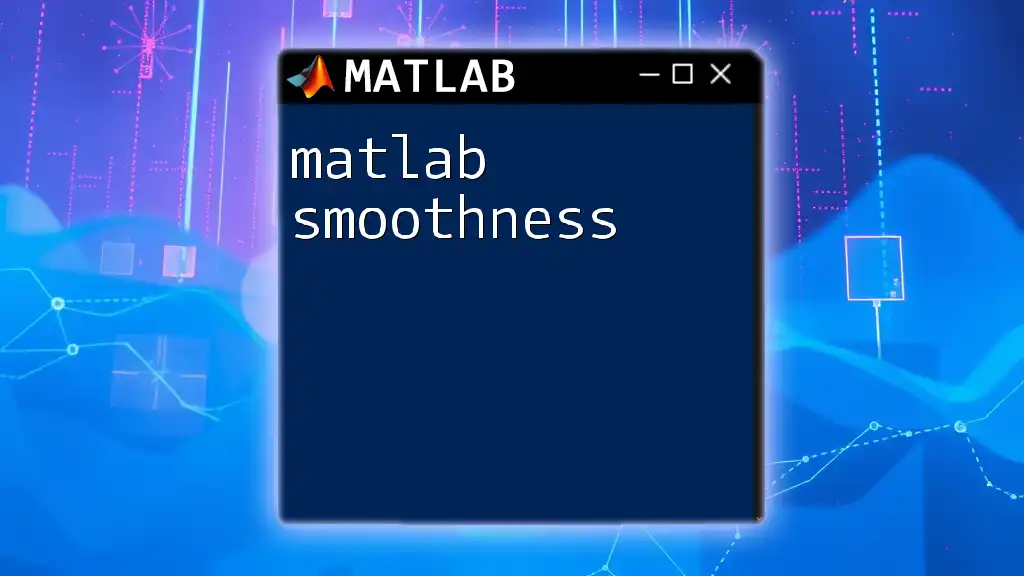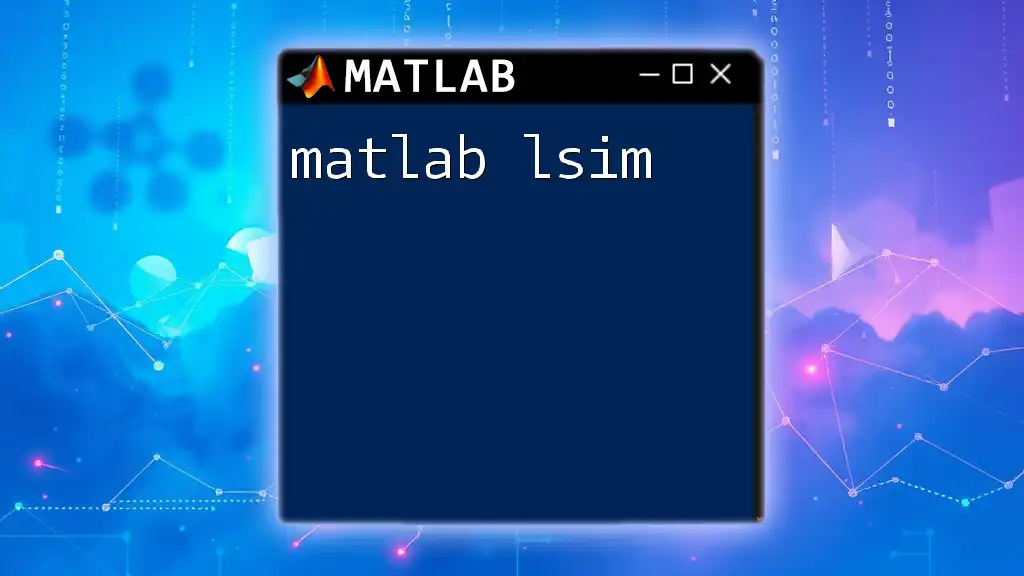The `symsum` function in MATLAB is used to compute the symbolic sum of a series of terms, allowing you to represent and manipulate infinite series expressions symbolically.
Here’s a code snippet example:
syms n;
f = n^2;
result = symsum(f, n, 1, inf);
disp(result)
What is `symsum`?
`symsum` is a powerful command in MATLAB that performs symbolic summation of expressions. Unlike standard numerical summation, `symsum` leverages the capabilities of symbolic mathematics, allowing you to represent and manipulate mathematical expressions in their symbolic form. The ability to handle symbolic variables and functions gives `symsum` a significant advantage in solving complex mathematical problems, particularly in theoretical studies where exact solutions are preferable.
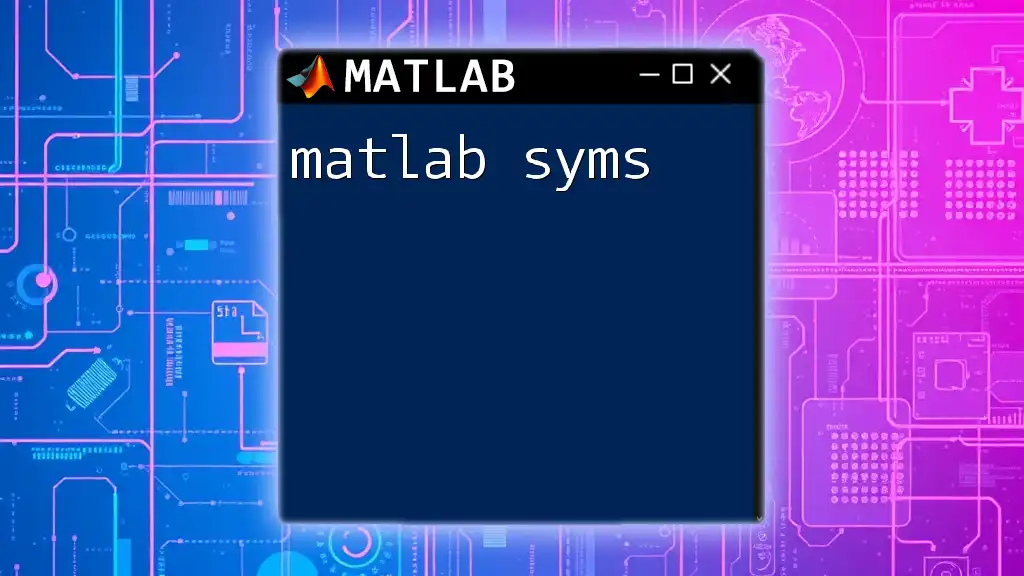
Syntax of `symsum`
The syntax for `symsum` is designed to be intuitive and straightforward:
Basic Syntax:
S = symsum(F, V)
Detailed Syntax:
S = symsum(F, V, Vmin, Vmax)
Breakdown of parameters:
- F: This is the expression to be summed. It can involve symbolic variables and can be a function of the summation variable.
- V: This parameter represents the variable of summation. It must be declared as a symbolic variable using the `syms` function.
- Vmin: This optional parameter sets the lower limit for the summation.
- Vmax: This optional parameter defines the upper limit for the summation.

Getting Started: Setting Up the Environment
Before you can use `symsum`, you need to set up your MATLAB environment. Open MATLAB and create a new script file. Within the script, make sure you have access to the necessary symbolic toolbox, which should be included in most MATLAB installations. You can initiate symbolic variables by using the `syms` function, which helps to prepare your workspace for symbolic operations.

Creating Symbolic Variables
To use `symsum`, you first need to define your symbolic variables. This is done using the `syms` function. For example:
syms x
This command creates a symbolic variable `x`. You can create multiple symbolic variables in one line:
syms x y z
These symbolic variables can now be used in expressions that you want to sum symbolically.
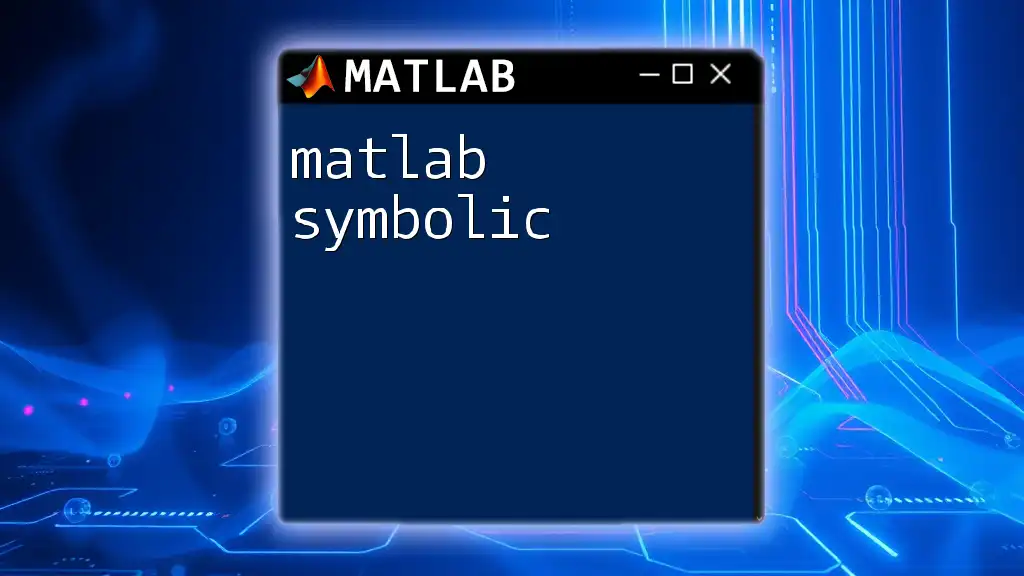
Basic Usage of `symsum`
Example 1: Simple Summation
Let’s start with a simple example of summing a series of integers from 1 to 10. Here’s how you do it using `symsum`:
syms n
S = symsum(n, n, 1, 10)
In this code, `n` is the variable of summation, and we're summing `n` from 1 to 10. The output, S, will give you the result of the addition, which is 55. This is a straightforward demonstration of how `symsum` can be used to compute sums involving symbolic variables.
Example 2: Summing a Function
Now, let’s sum a quadratic function over a specified range. Here’s an example:
S = symsum(n^2, n, 1, 5)
In this case, we are summing the squares of `n` from 1 to 5. The expected output will be 55 (i.e., \(1^2 + 2^2 + 3^2 + 4^2 + 5^2\)). This example illustrates the ability of `symsum` to handle more complex expressions beyond simple series.

Using `symsum` for Infinite Series
Example 3: Infinite Summation
The `symsum` function is also capable of handling infinite series. For instance, consider the series for \( \sum_{n=1}^{\infty} \frac{1}{n^2} \):
S = symsum(1/n^2, n, 1, inf)
The command above returns \( \frac{\pi^2}{6} \), showing the convergence of the series to this well-known result. This feature is advantageous for mathematicians and engineers who may encounter infinite series in their work.

Combining `symsum` with Other Functions
Example 4: Using in conjunction with `sym` and `limit`
You can extend the functionality of `symsum` by combining it with other symbolic math functions in MATLAB. For example:
syms n x
S = symsum(x^n/n!, n, 0, inf);
This code sums the series that resembles the expansion of the exponential function \( e^x \). By analyzing this output, we see how `symsum` can be integrated with function definitions, making it an invaluable tool for symbolic computation in advanced mathematical contexts.

Tips for Effective Usage
When using `symsum`, keep in mind the potential pitfalls. Common issues include:
- Undefined variables: Ensure all variables used in your expression are defined as symbolic.
- Improper limits: Be careful when specifying the limits of summation; incorrect limits can yield misleading results.
- Complex expressions: While `symsum` can handle complex expressions, clarity in your code will help you avoid mistakes and improve readability.
Best Practices:
- Always declare your symbolic variables at the beginning of your code.
- Break down complex summation problems into smaller, manageable pieces.
- Regularly check your output against known mathematical results to verify accuracy.

Advanced Applications of `symsum`
Example 5: Applications in Physics and Engineering
In the field of physics, `symsum` can be instrumental in solving problems involving series expansions, such as Fourier series or calculating moments in statistical mechanics. For instance, summing the terms of a force series allows engineers to analyze system behavior under specific conditions systematically.
Example 6: Statistical Applications
In statistics, `symsum` can be utilized in computing probabilities, particularly in discrete distributions. Here’s an example that sums probabilities in a distribution:
syms n
p = 1/(2^n); % probability of a geometric distribution
S = symsum(p, n, 0, inf);
This code snippet computes the total probability of a geometric distribution summing over all possible values of `n`, returning a value of 1 (indicating complete certainty). Such applications highlight how `symsum` can bridge abstraction with practical applications.

Conclusion
In summary, mastering the matlab symsum function can significantly enhance your ability to perform symbolic mathematics, whether for educational, research, or engineering purposes. Its capabilities in handling both finite and infinite series provide a robust framework for tackling complex summation problems. Embrace the power of symbolic mathematics, and remember to practice regularly to strengthen your understanding.

Additional Resources
For further exploration of MATLAB's capabilities, consider visiting the official MATLAB documentation for `symsum` and engaging with communities and forums dedicated to MATLAB programming. Further reading on symbolic mathematics may also enrich your knowledge and skills in this essential area of computational math.

Call to Action
If you found this guide valuable, follow our blog for more tips on using MATLAB effectively. Join our workshops to deepen your understanding and enhance your skills in symbolic mathematics!

